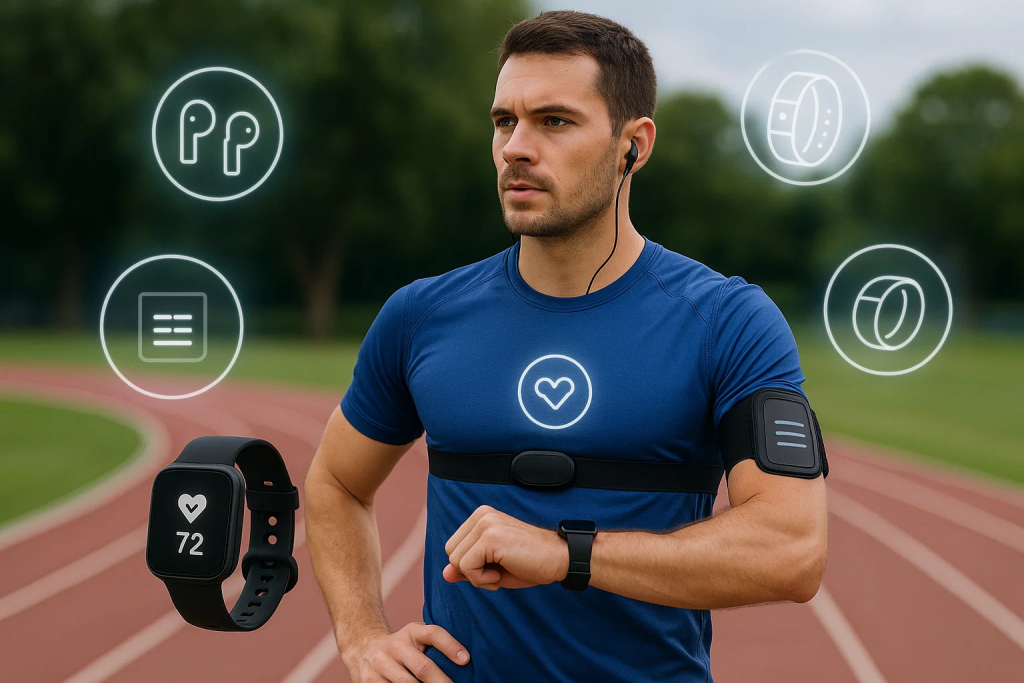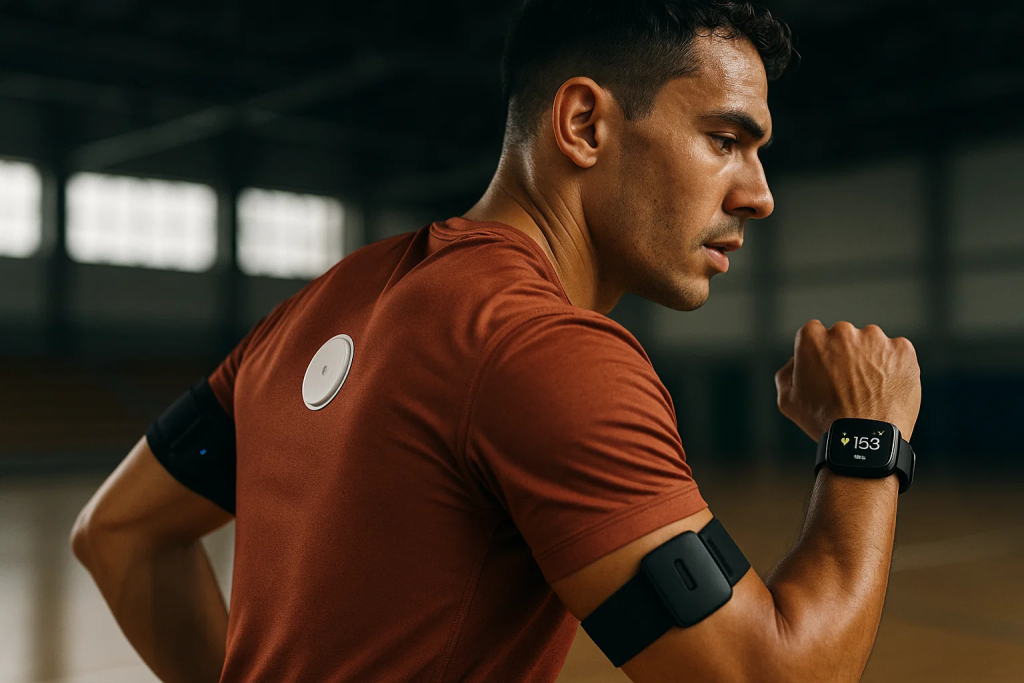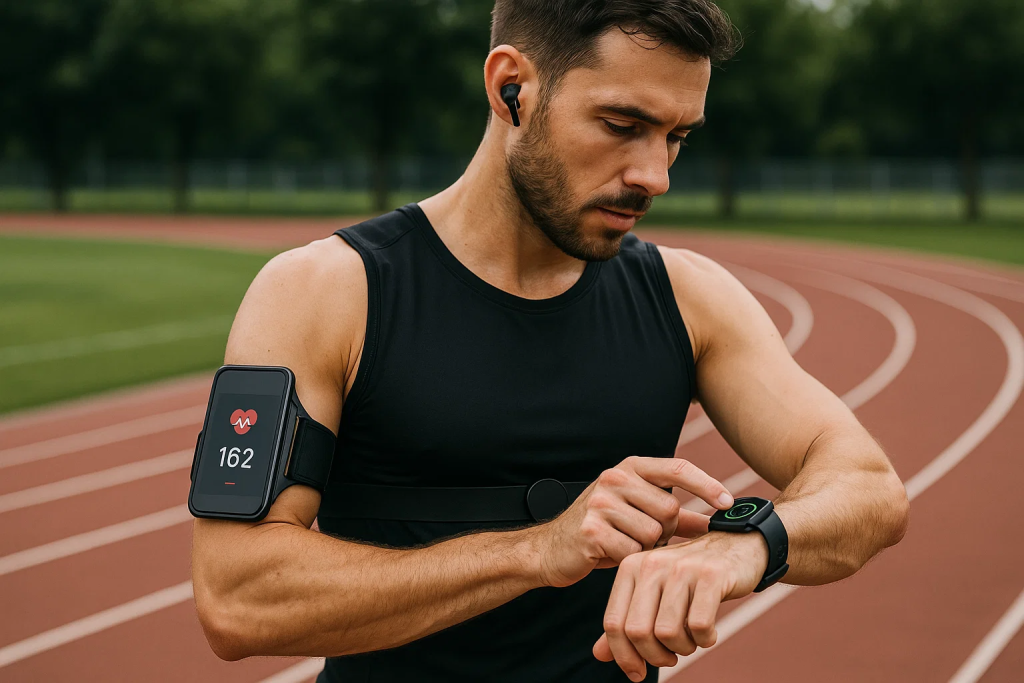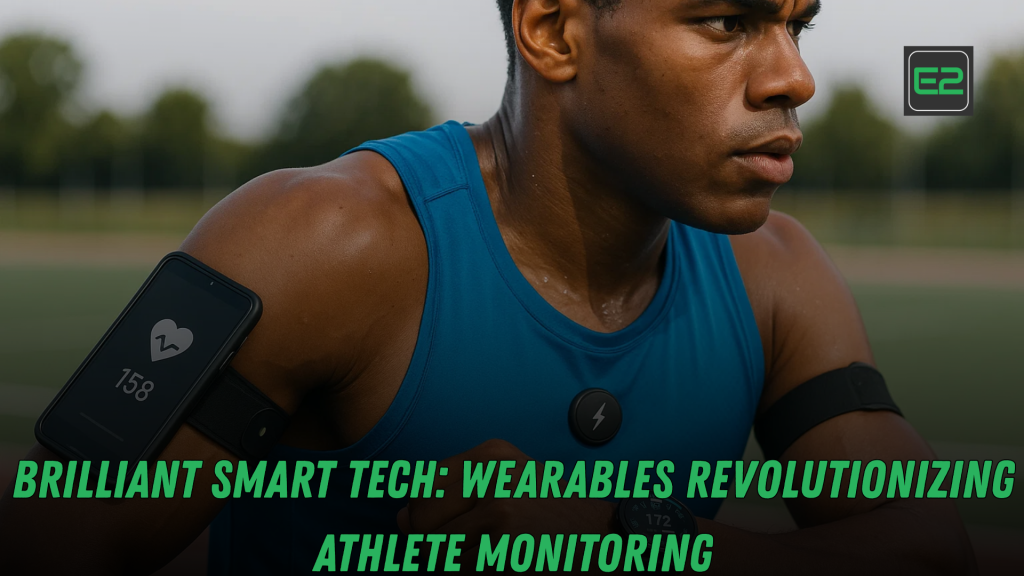Table of Contents
Wearable technology has moved far beyond step counts and novelty gadgets. In elite sport, collegiate programs, and serious amateur scenes, smart wearables now sit at the center of athlete monitoring—streaming biometric data in real time, turning training into a measurable, optimizable system. From heart-rate variability (HRV) to GPS load, from sleep and recovery scores to muscle oxygen saturation (SmO₂) and sweat analytics, the modern training ecosystem is quantified, connected, and increasingly AI-assisted.
This comprehensive, SEO-friendly guide shows coaches, sport scientists, strength & conditioning (S&C) specialists, medical staff, and performance-minded athletes how to plan, choose, integrate, and actually use wearables to make better decisions. You’ll learn which metrics matter, what devices belong in your stack, how to avoid data overload, how to secure data privacy, and how to pilot a full program in 90 days—with templates, checklists, and KPIs you can start using today.

TL;DR — The Big Picture
- Why it matters: Wearables close the loop between training inputs and performance outputs. They improve availability (fewer injuries), adaptation (better gains), and readiness (peak on the right day).
- What to monitor: Internal load (HR, HRV, RPE), external load (speed, distance, accelerations, collisions), recovery (sleep stages, SpO₂, body temp), tissue status (muscle oxygenation, jump metrics), and context (environmental heat, hydration).
- How to win with data: Start small, align metrics with performance questions, automate reporting, and translate numbers into clear actions—adjust volume, modulate intensity, flag red-days, and personalize recovery.
- Risks to manage: Data privacy, athlete consent, context-free metrics, and shiny-object syndrome. Adopt a governance framework, define ownership, and train staff to use data ethically.
What Exactly Are “Wearables” in Athlete Monitoring?
Wearables are body-worn sensors and connected devices that capture physiological and biomechanical data during training, competition, and recovery. Common categories include:
- Wrist, ring, and patch sensors – HR, HRV, SpO₂, skin temp, sleep, activity, stress proxies.
- GPS/LPS units and IMUs – Track external load: total distance, high-speed running, accelerations/decelerations, PlayerLoad™, jump count, impacts.
- Heart-rate straps & optical HR – High-fidelity heart rate during field work.
- Muscle oxygenation (NIRS/SmO₂) – Insight into local muscle oxygen delivery/utilization during intervals or strength sets.
- EMG shorts/patches – Muscle activation timing and fatigue markers (advanced/experimental in field settings).
- Smart insoles & foot pods – Ground-contact time, asymmetry, cadence, stiffness proxies.
- Hydration, sweat, and glucose wearables – Electrolyte loss, sweat rate, and glucose trends for fueling and cramp prevention.
- Smart garments & bands – Multi-sensor compression tops, sleeves, or shirts for ECG-like signals, respiration, posture.
- Environmental sensors – Heat index, WBGT, air quality, and altitude, paired with athlete data for context.
Core idea: Combine internal load (how hard the session was on the body) with external load (what the athlete did) and readiness/recovery (how prepared the athlete is today). The intersection—dose–response—is where decisions live.
The Metrics That Actually Matter (and Why)
Internal Load & Readiness
- Heart Rate (HR): Foundation metric; links intensity to physiological cost. Use to target zones, control tempo runs, and validate pacing on fatigued days.
- Heart-Rate Variability (HRV): Proxy for autonomic balance. Morning HRV trends indicate readiness to push, hold, or deload. Look for multi-day trends, not single-day noise.
- Resting HR & Body Temperature: Early flags for illness or insufficient recovery.
- RPE & sRPE (Session RPE): Athlete-reported load; essential context to keep the human in the loop.
External Load
- GPS speed & distance: Segment by zone (e.g., high-speed running >19–20 km/h in football codes).
- Accelerations/Decelerations & Change of Direction (COD): Tissue-demanding metrics; overexposure correlates with soft-tissue risk.
- Impacts/Collisions: Rugby, American football, hockey—monitor cumulative trauma.
- Jump volume & height: Volleyball, basketball—track exposure and asymmetry.
Recovery & Sleep
- Sleep duration & efficiency: Under 7 hours consistently? Expect plateaus, irritability, or injury risk.
- Sleep stages (REM/deep): Imperfect but directionally helpful; pair with subjective sleep quality.
- SpO₂ & Respiration Rate: Useful at altitude and for illness surveillance.
Tissue & Metabolic Insight
- SmO₂ (muscle oxygen): Guides interval rest, reveals local limitations, and individualizes load (e.g., when to cut a set).
- Jump-based neuromuscular tests (CMJ, RSI): Track neuro fatigue; pairs well with HRV for daily readiness.
- Glucose trends & fueling: For endurance and tournament formats, glucose wearables help dial carb timing and avoid bonks/late-game fades.
- Sweat rate & electrolytes: Prevent cramping, dizziness, and late-session drop-offs—especially in heat.
Pro tip: Good monitoring programs connect a few complementary metrics (e.g., HRV + sleep + CMJ + GPS HSR) rather than chasing every sensor on the market.
From Data to Decisions: The Performance Workflow
Step 1: Define the questions.
- “How do we build speed without spiking hamstring risk?”
- “Which midfielders are red-zoned after a congested schedule?”
- “How do we taper for a Saturday final while keeping intensity touchpoints?”
Step 2: Choose the minimal viable metrics.
- Speed/HSR, Acc/Dec, HRV, sleep, CMJ, sRPE.
Step 3: Standardize collection.
- Morning HRV/sleep sync, pre-session CMJ (2–3 jumps), GPS/HR during field, post-session survey (RPE, soreness, mood).
Step 4: Automate dashboards & flags.
- Daily red/amber/green readiness; weekly load trend; monthly injury exposure report.
Step 5: Translate to action.
- Red readiness? Cap HSR, shift to technical/skill work.
- Amber? Maintain volume, reduce COD or collisions.
- Green? Progress intensity or micro-dose top-speed.
Step 6: Review & iterate.
- End of mesocycle: compare planned vs. actual load, injuries, and performance KPIs; tune thresholds.
Sport-Specific Use Cases (with Actions You Can Copy)
Football/Soccer
- Need: Balance high-speed running (HSR) and COD without hamstring overload.
- Stack: GPS (speed zones, Acc/Dec), HR strap, morning HRV, CMJ.
- Actions:
- Top-speed micro-doses (2–3 flying 30s) 2×/week when green.
- On tight fixtures, cap COD and collisions; focus on technical speed.
- Flag players with HSR spikes >20–30% week-over-week for individualized recovery.
Basketball
- Need: Manage jump volume and tendinopathy risk; maintain repeat-sprint ability.
- Stack: IMU for jumps/landing load, HRV + sleep, CMJ, GPS/indoor tracking if available.
- Actions:
- Red-flag when landing asymmetry or jump count surges; swap plyos for isometrics.
- Keep high-intensity micro-exposures even during congested road trips (short fly-ins).
Rugby/American Football
- Need: Collisions + HSR + heat management.
- Stack: GPS (impacts, HSR), HR strap, WBGT/heat sensor, hydration wearables.
- Actions:
- Limit collisions for red-flagged players; experiment with heat acclimation blocks and electrolyte plans.
- Use position-specific thresholds—front row vs. backs, linemen vs. receivers.
Endurance (Running, Cycling, Tri)
- Need: Fueling, pacing, altitude, overuse injury prevention.
- Stack: HRV, HR/pace/power, glucose wearable (where appropriate), SmO₂, sleep.
- Actions:
- Use SmO₂ to time intervals (start next rep at recovered local oxygenation).
- Align glucose trends with RPE to refine carb timing; avoid over-or under-fueling.
Combat & Court Sports (Tennis, Badminton, MMA)
- Need: COD density, shoulder load, weight management, rapid recovery.
- Stack: IMU (shoulder/elbow proxies), HRV, sleep, jump/COD tests.
- Actions:
- Cap COD bursts when HRV depressed; emphasize tactical sparring or shadow rounds.
- Incorporate breath control sessions on red days to restore parasympathetic tone.
Choosing the Right Wearables: A Buy-Smart Framework
1) Start with your questions, not the catalog.
If you can’t finish the sentence “We’ll use this metric to decide ____,” you don’t need that sensor—yet.
2) Prioritize signal fidelity and ergonomics.
Field conditions are messy. Pick devices with reliable capture during sprints, collisions, sweat, and rain—and that athletes forget they’re wearing.
3) Integration over perfection.
One decent device that pushes clean data into your analytics beats a “best-in-class” sensor that lives in a proprietary silo.
4) Support & workflow fit.
Ask about APIs, auto-sync, battery life, strap durability, firmware cadence, and how long it takes to get a daily report out. Time is your most expensive resource.
5) Budget tiers & ROI.
- Tier 1 (Solo athlete / small club): Wrist wearable + HR strap + CMJ via force plate app or jump mat alternative.
- Tier 2 (Amateur team / academy): Add GPS/IMU pods, sleep rings or patches; basic dashboarding.
- Tier 3 (Pro/college): Full GPS fleet, indoor LPS, SmO₂ units for lab-to-field testing, hydration/glucose for selected positions, custom data warehouse.
Building the Athlete Monitoring Stack (Architecture That Scales)
- Collection layer: Wearables (GPS/IMU, HR strap, ring/patch, SmO₂), surveys, testing devices.
- Ingestion & ETL: Auto-sync to cloud, unify timestamps, handle duplicates, flag missing data.
- Data model: Athlete-centric schema with session, metric, context tables + device metadata.
- Analytics & alerts: Thresholds by position and phase (pre-season, in-season), rolling averages (7/28-day), acute:chronic logic with governance to avoid simplistic ratios.
- Visualization: RAG (red/amber/green) daily board, weekly load trend, position group comparisons, return-to-play tracker.
- Action layer: Individual plans: reduce HSR, swap COD, add isometric holds, extra sleep block, electrolyte protocol.
Outcome focus: Every chart should imply a decision. If the dashboard doesn’t change a session, it’s decoration.

Avoiding the Traps: Common Mistakes (and Better Alternatives)
- Mistake: Chasing novelty metrics without a plan.
Fix: Tie metrics to decisions; sunset unused sensors quarterly. - Mistake: Over-interpreting single-day dips.
Fix: Use trends and context (travel, heat, academic stress, menstrual cycle). - Mistake: Ignoring the athlete voice.
Fix: Pair wearables with short subjective surveys (sleep quality, soreness, mood, stress). - Mistake: One-size-fits-all thresholds.
Fix: Individualize by baseline, training age, and position. - Mistake: Privacy afterthought.
Fix: Consent first, role-based access, retention policy, and transparent communication.
Ethics, Compliance & Data Privacy of Wearables in Sports
Athlete data is sensitive. Treat it like medical information:
- Informed consent: Why you collect, what you store, who sees it, when it’s deleted.
- Role-based access: Coaches see actionable summaries; medical staff view deeper clinical signals; athletes can access their own data.
- Data minimization: Collect only what answers your performance questions.
- Retention & deletion: Set timelines; respect transfers and off-boarding.
- Education: Teach athletes what HRV, HSR, and sleep metrics mean—and what they don’t. Empowered athletes buy in.
The 90-Day Rollout Plan (Pilot to Proof of Value)
Phase 1 — Weeks 1–3: Design & Setup
- Pick two performance questions and five metrics max.
- Acquire devices; define testing battery (CMJ, 10–30 m sprint, isometric mid-thigh pull, or sport-specific).
- Draft consent forms, privacy policy, and data access rules.
- Build daily workflow (when to wear, charge, sync), choose dashboarding tool, and set RAG rules.
Phase 2 — Weeks 4–8: Baseline & Training
- Collect baseline: HRV (10–14 days), sleep habits, CMJ, GPS profiles.
- Run training as usual; do not change practice yet.
- Deliver weekly 1-page report to staff: wins, risks, quick recommendations.
Phase 3 — Weeks 9–12: Action & Evaluation
- Activate decision rules: cap spikes, micro-dose top-speed, personalize recovery.
- Track KPIs: soft-tissue incidents, red-day exposures, match availability, wellness scores, performance test changes.
- End-of-pilot review: What actions were taken? What outcomes moved? What’s ROI?
Deliverables you should have by Day 90:
- A repeatable morning routine, pre-session test, and post-session debrief.
- A dashboard everyone understands in under 60 seconds.
- Evidence that monitoring changed sessions and improved availability or performance.
Interpreting Red, Amber, Green (RAG) Readiness in Wearables—Without Guesswork
- Green: Proceed as planned. Consider a small intensity “win” to maintain adaptations.
- Amber: Adjust one factor—volume, intensity, COD density, collision count, or environmental heat.
- Red: Technical/tactical emphasis, breathwork, mobility, or extra recovery. If repeated, schedule a multidisciplinary check-in.
Remember: RAG is guidance, not a verdict. Always contextualize with athlete feedback and staff observations.
Beyond Training: Recovery, Travel, and Tournament Play
- Sleep banking: Before travel or a tournament, aim for 8–9 h for 3–5 nights; HRV and mood respond positively.
- Jet-lag protocol: Anchor meals and light exposure at destination times before departure; keep hydration and mild movement on travel days.
- Back-to-back days: Use morning HRV + CMJ to decide who gets reduced workload or different roles.
- Heat strategy: Pre-cool (ice towels, slushies), during-play cooling breaks, and post-session rehydration guided by body mass changes and sweat wearables.
What Success Looks Like (KPIs that Matter)
- Availability: % of roster available for full training/match.
- Soft-tissue injuries: Absolute number and days lost.
- Load management: Reduced weekly spikes; more exposures in the “sweet spot.”
- Performance: Sprint PRs maintained in-season, improved jump metrics, position-specific outputs.
- Engagement: Survey compliance ≥85%, device sync ≥95%, coach report open rate ≥90%.
Glossary (Fast Context for Staff & Athletes)
- HRV (Heart-Rate Variability): Beat-to-beat variation; higher (within personal norm) often indicates better readiness.
- HSR (High-Speed Running): Distance covered above a sport-specific speed threshold.
- SmO₂ (Muscle Oxygen Saturation): Balance of O₂ supply vs. usage in the muscle you’re monitoring.
- RPE/sRPE: Rating of Perceived Exertion; sRPE = RPE × session duration (min).
- CMJ (Countermovement Jump): Quick neuromuscular readiness test; track height and RSI (reactive strength index).
- ETL/Internal/External Load: ETL = External Training Load (work done); internal = the body’s response.
- RAG: Red/Amber/Green flag system for readiness or risk.
On-Page SEO Tips for This Topic
- Primary keyword: athlete monitoring wearables
- Secondary keywords: sports performance analytics, HRV for athletes, GPS tracking in sports, injury prevention technology, recovery wearables, sleep tracking for athletes, muscle oxygen sensors, AI coaching.
- URL slug:
/wearables-athlete-monitoring-guide - H2/H3 structure: Keep topic clusters (e.g., Metrics, Workflows, Privacy, Rollout Plan).
- Image alts: “athlete wearing GPS pod during sprint drill,” “coach reviewing RAG dashboard,” “sleep tracking ring for recovery.”
- Internal links: Link to pages about injury prevention, return-to-play, nutrition & hydration, and strength programs.
- Schema: Consider FAQPage and Article schema (see snippet below).
Strong Call-to-Action (CTA)
Ready to turn numbers into wins? Download our 90-Day Athlete Monitoring Checklist, or leave a comment with your sport, level, and current challenges. We’ll help you pick a lean, high-impact wearable stack and design the dashboards that coaches actually use. Subscribe for monthly performance playbooks and practical case studies.

Amazing PH Basketball Draft Preview: Who Are the Dark Horses?
Frequently Asked Questions
1) Which wearables are best for athlete monitoring?
Answer: The “best” wearables are the ones that answer your specific performance questions and fit your workflow. For most teams, a GPS/IMU system (external load), heart-rate strap (internal load), and a sleep/HRV wearable (readiness) form a strong foundation. Add CMJ testing, and consider muscle oxygen or hydration/glucose solutions for advanced needs. Prioritize integration, battery life, and comfort.
2) What are the first metrics we should track if we’re starting from zero?
Answer: Begin with a minimal viable set: HRV (morning readiness), sleep duration/quality, sRPE after each session, GPS high-speed running and acc/dec counts, plus a simple CMJ test 2–3×/week. This small set covers internal load, external load, and neuromuscular status without overwhelming staff.
3) How do we prevent data overload and actually use the numbers?
Answer: Tie each metric to a decision. Build a RAG dashboard that auto-updates daily. Use if-this-then-that rules (e.g., “Red HRV + low CMJ → cap COD and collisions”). Review weekly with coaches to ensure data changed the session. Sunset any metric you haven’t used in a month.
4) Can wearables really reduce injuries or is that hype?
Answer: Wearables aren’t magic, but they improve decision-making. Stabilizing external load, avoiding acute spikes, individualizing recovery, and flagging early-warning trends (sleep debt, HRV dips, asymmetries) all contribute to better availability. Pair the data with great coaching, strength work, and communication.
5) What about privacy—who owns athlete data and how do we stay compliant?
Answer: Treat athlete data like medical information. Use informed consent, role-based access, secure storage, and clear retention/deletion policies. Be transparent: explain what you collect, why, and how it benefits athletes. Give athletes access to their own data and the right to opt out of non-essential metrics.
Final Word
Wearables have shifted athlete monitoring from guesswork to guided action. When you align the right metrics with clear decisions, your program gets what truly matters: more athletes available, better adaptation to training, and peak performances when it counts. Start lean, automate the boring parts, and keep the athlete voice front and center. Your future self (and your win-loss column) will thank you.
